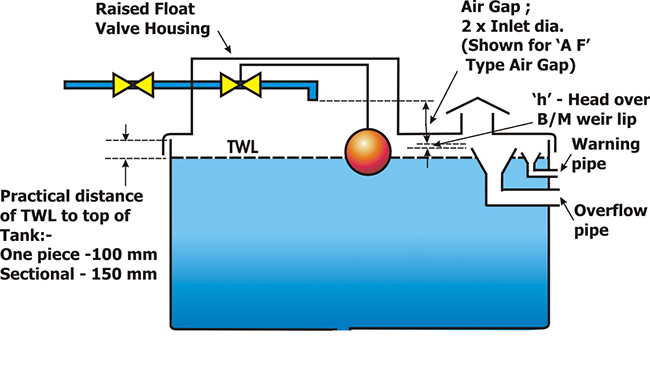THE ATCM Maximising cistern or tank holding capacity

Maximising the actual holding capacity of any cistern or tank has to be beneficial both in space saving and overall cost. Bellmouth Overflow and Raised Float Valve Housing fittings are important add on features available to the tank designer to assist in achieving this goal..
It is a fact that most tanks and cisterns are 2 m deep or less. Industry analysis advises 98% of GRP One Piece and 80% of Sectional Tanks are in this category. In fact 49% of all Sectionals Tanks installed are only 1 m in depth. All Thermoplastic Cisterns are invariably less than 1 m in depth.
 |
| The sketch above shows a typical arrangement |
So what is the implication of these facts? Most cisterns and tanks actually contain liquid volumes that are well below their nominal capacity. Resultant on Regulatory requirements and F/V design in conventional plumbing arrangements, considerable internal space is allocated to storing air. In general terms, as tank height reduces, the greater is the proportionate loss in actual capacity.
For a tank 1m deep, supplied via a 50mm Float Valve, set with a regulation air gap, O/F etc., maximum TWL could not be higher than 550mm above tank base level. Hence, 55% actual capacity available and resultant on outlet pipe location, probably only 40% effective actual capacity.
For small capacity tanks used for domestic purposes this actual loss of capacity will not be troublesome. The normally fitted 15 mm F/V will provide a TWL at a proportionately higher level and intermittent usage, allows replenishment to take place in good time for normal use. Difficulty arises when larger actual storage capacities are required and where demand is greater, possibly a break tank duty and / or where space is restricted. The proverbial quart into the pint pot scenario.
So the question is what to do? To maximise effective actual capacity it is necessary to raise the TWL and possibly install a Vortex Inhibitor on the Cold Feed Outlet to improve the draw-down capability.
Installing a Raised Inlet or Float Valve Housing coupled with a Bellmouth Overflow and Warning Pipe arrangement will almost double the effective capacity of a 1 m deep tank.
The benefit is more efficient tank assemblies – an increase in working capacity or the option of a smaller tank for the same expected performance.
The advantages to tank manufacturers are, though the basic assembly will be smaller and hence carry potentially less value pro-rata, the inclusion of specialised fittings make it possible to provide the capacity requirement whilst reaping the benefits of a higher added value product.
In other words, everyone is a winner, both Customer and Manufacture.
An ATCM/ Water Regulation Advisory Scheme (WRAS) Information and Guidance Note, written as a practical guide, will provide in detail the requirements for cold water tanks and cisterns. View the 1st link below.
Further information of the purpose and objectives of the ATCM is available at the 2nd link below. Note: The above information is advisory only.
Neil Weston – Chairman
Call us today! 0118 380 1980
E-mail: chairman@atcmtanks.org.uk
Website: see 2nd link below







